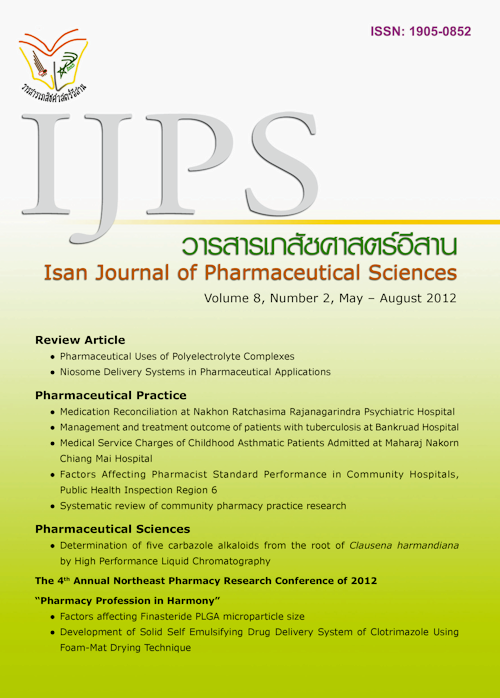Management and treatment outcome of patients with tuberculosis at Bankruad Hospital
Main Article Content
Abstract
Introduction: Tuberculosiswas an infectious disease which has been an important public health problemand cause of dead in many countries worldwide. Management of patients with tuberculosis including diagnosis andtreatment is the most important key for solving and controlling the disease. Objectives: To study the managementand the outcome in management of patients with tuberculosis at Bankruad Hospital, Buriram province. Materials andMethods: This study was retrospective observational study in new tuberculosis patients registered between October1, 2006 and September 30, 2009. The management system for tuberculosis patients composed of the providingclinical care and treatment of tuberculosis patients by the multidisciplinary team. Patients’ data including generalcharacteristic, diagnosis and treatment were collected from medical record. Descriptive statistics, Chi–square testand multiple logistic regression model were used for statistical analysis. Results: There were 124 patients recruitedinto the study, 83 males (66.9%) and 41 females (33.1%). One hundred and three patients (83.1%) hadpulmonarytuberculosis, 20 patients (16.1%) hadextra-pulmonary tuberculosis, and 1 patient (0.8%) had pulmonary tuberculosiswith extra-pulmonary tuberculosis. Most of patients hadfollowingdata; 71 patients (57.3%) with positive sputumtest, 90 patients (72.6%) with chest X-ray found infiltration, and 107 patients (86.3%) with negative HIV test. Onehundred and eight patients (87.1%) were treated with 2HRZE(S)/4HR regimen. The major drug related problemwas inappropriate dosage regimen found in 68 patients (54.8%) followed by adverse drug reaction found in 19patients (15.3%). Most of patients, 114 patients (91.9%) had good compliance and 112 patients (90.3%) were treatedsuccessfully. Data analysis showed that positive HIV test, suptherapeutic dose of rifampicin and non-compliancewere associated with poor treatment outcome. Conclusion: Management of patients with tuberculosis at BankruadHospital was consistent with the National Tuberculosis Program (NTP) and the high treatment success.
Article Details
In the case that some parts are used by others The author must Confirm that obtaining permission to use some of the original authors. And must attach evidence That the permission has been included
References
Anunnatsiri S, Chetchotisakd P, Wanke C. Factors associated with treatments outcomes in pulmonary tuberculosis in northeastern Thailand. Southeast Asian J Trop Med Public Health 2005; 36: 324-30.
Bureau of Tuberculosis Department of Disease Control Ministry of Public Health. Treatment of tuberculosis in adults. Guideline of national tuberculosis control management. Bangkok: Agriculture Cooperative Printing Authority of Thailand; 2008: 31-48.
Bureau of Tuberculosis Department of Disease Control Ministry of Public Health. The relationship between tuberculosis and HIV/AIDS.TB-HIV guideline 2008. Bangkok: Printing office of National Buddhism; 2008: 1.
Chengsorn N, Bloss E, Anekvorapong R, et al. Tuberculosis services and treatment outcomes in private and public health care facilities in Thailand, 2004–2006. Int JTuberc Lung Dis2009; 13: 888–94.
Cohen FL. Adherence to therapy in tuberculosis. Annu Rev Nurs Res 1997; 15: 153–84.
Helper D, Strand L. Opportunities and responsibilities in pharmaceutical care. AJHP 1990; 47:533-43.
Kerdnoo R. Impact of care program on cure rate of pulmonary tuberculosis patients at Prachuap-Khiri Khan [Thesis for the degree Master of Pharmacy, Program of Clinical Pharmacy]. Bangkok: Graduate School, Silpakorn University; 2005.
Krejcie RV, Morgan DW. Determining sample size for research activities.Educational and psychological measurement 1970; 30: 607-10.
Morsy AM, Zaher HH, Hassan MH, Shouman A. Predictors of treatment failure among tuberculosis patients under DOTS strategy in Egypt.EMHJ 2003; 9: 689-701.
Okanurak K, Kitayaporn D, Wanarangsikul W, Koompong C. Effectiveness of DOT for tuberculosis treatment outcomes: a prospective cohort study in Bangkok, Thailand.Int JTuberc Lung Dis 2007; 11: 762-8.
Okanurak K, Kitayaporn D, Akarasewi P. Factors contributing to treatment success among tuberculosis patients: a prospective cohort study in Bangkok.Int J Tuberc Lung Dis 2008; 12: 1160–5.
Panpuvong S, Piyaattakit P, Panpuvong N, Battsung-noen A. Treatment outcome of tuberculosis patients by multidisciplinary team at Waritch-aphum Hospital, SakonNakhon Province.IJPS2008; 4 (2): 57-64.
Srisaenpang S. Burden & trend of infectious tuberculosis patients, their treatment outcomes andassociated factors for the treatment success at Khon Kaen Medical School during 1997-2001. [Thesis for the degree of Doctor of philosophy (Tropical medicine)]. Bangkok: Faculty of Graduate Studies Mahidol University; 2006.
Tatro DS. Drug Interaction Facts. USA: Wolters Kluwer Health; 2008.
Thongraung W, Kasinwat N, Limcharoen N, Nooratkaew K. Adverse reaction during the use of anti-tuberculosis drugs and unsuccess in treatment. Thai Pharm Health Sci J 2008; 4: 46-51.
Unamornchaiyakul S. Effect of pharmaceutical care on patients with tuberculosis at Yasotorn Hospital. [Thesis for the degree of Doctor of Pharmacy]. Mahasarakham: Faculty of Pharmaceutical Sciences, Mahasarakham University; 2008
Wang CS, Chen HC, Yang C.J, Wang WY, Chong IW, Hwang J.J. et al. The impact of age on the demographic, clinical, radiographic characteristics and treatment outcomes of pulmonary tuberculosis patients in Taiwan. Infection 2008; 36, 335-40.
World Health Organization. Treatment of tuberculosis: guidelines. 4th ed. Geneva: WHO 2010: 83-92.


